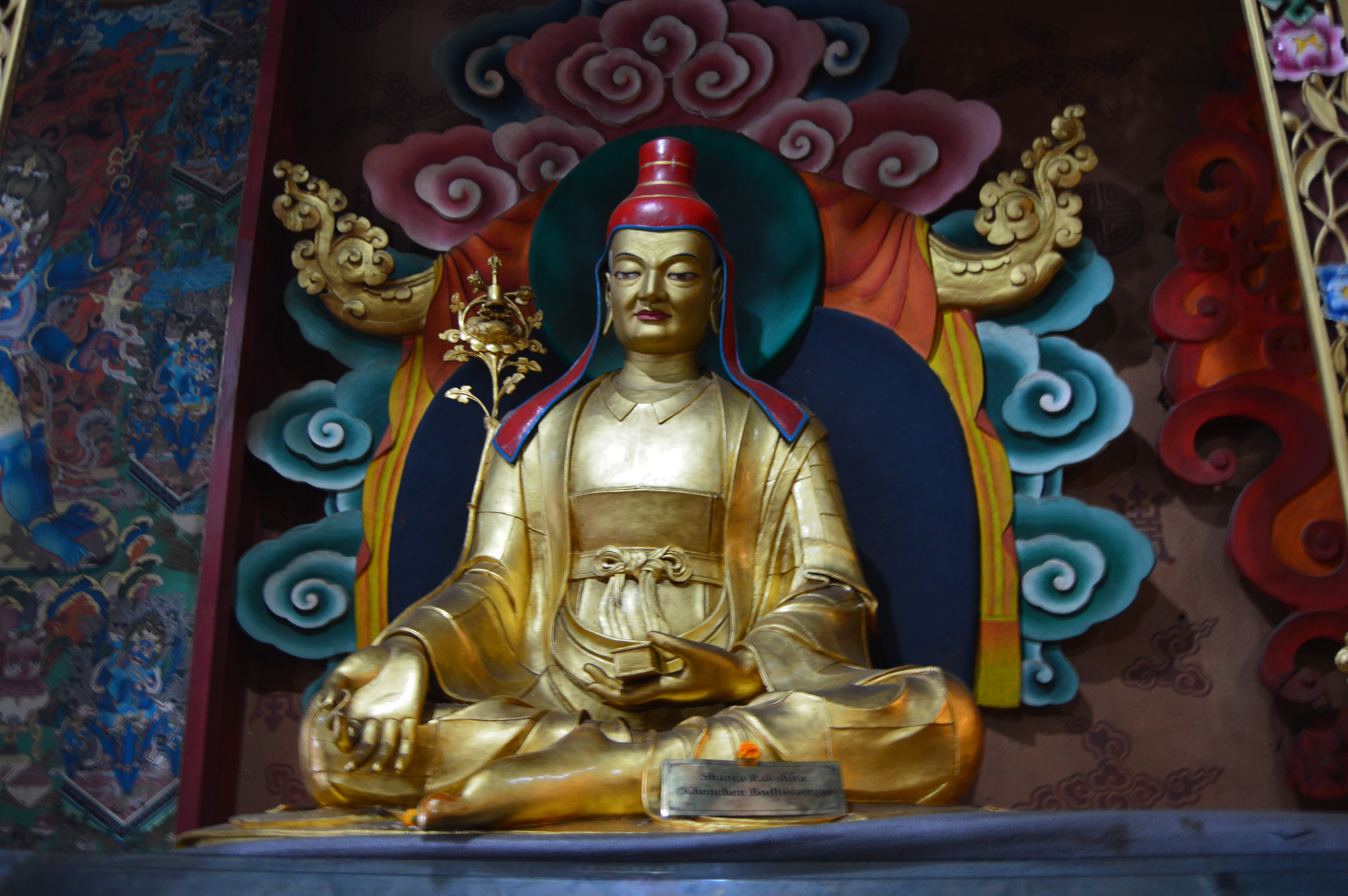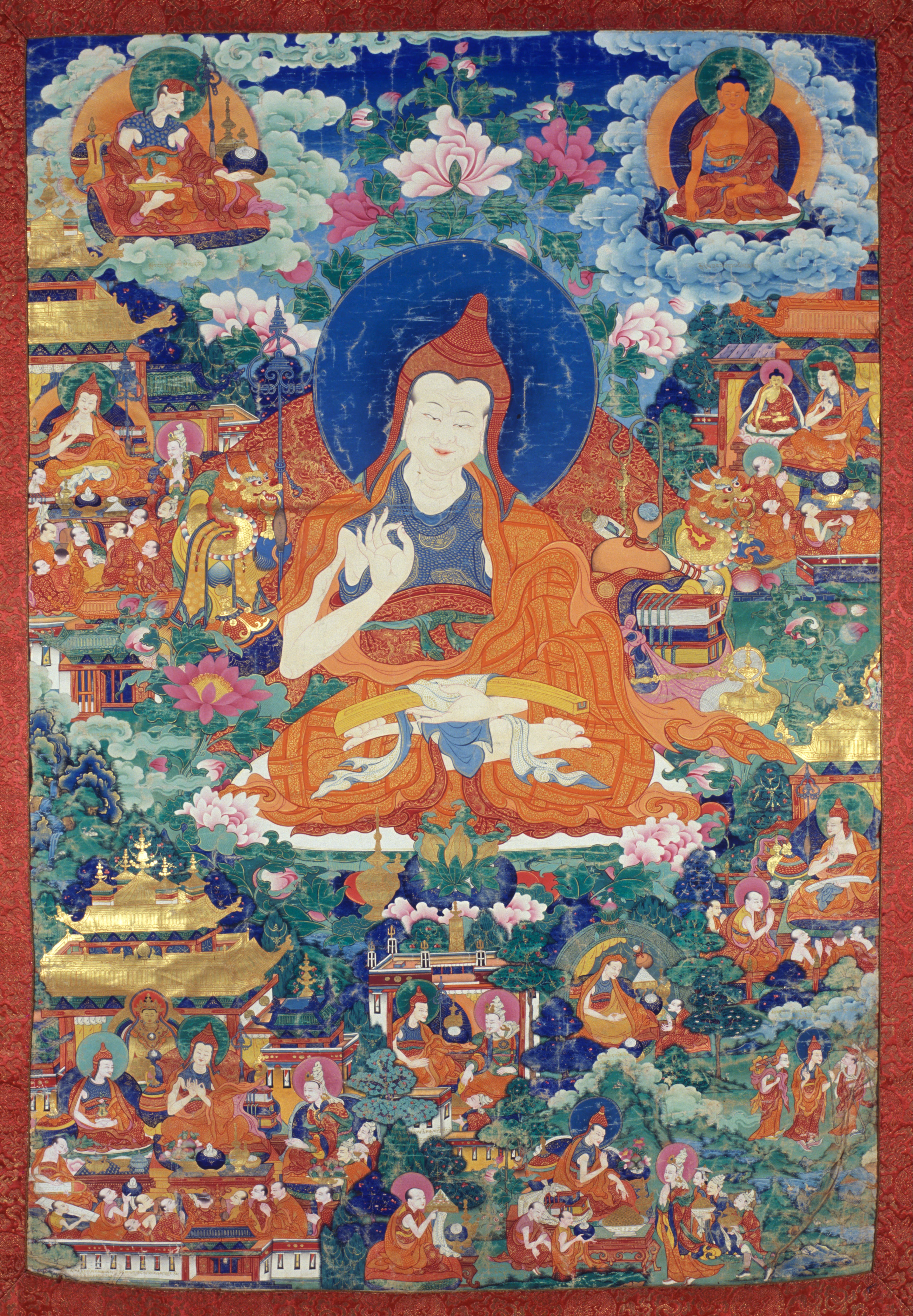|
Madhyamakālaṃkāra
The ''Madhyamakālaṃkāra'' () is an 8th-century Buddhist text, believed to have been originally composed in Sanskrit by Śāntarakṣita (725–788), which is extant in Tibetan. The Tibetan text was translated from the Sanskrit by Surendrabodhi () and Jñānasūtra. Text In the short-verse text of the ''Madhyamakālaṃkāra'', Śāntarakṣita details his philosophical synthesis of the conventional truth of Yogacara with the ultimate truth of the Madhyamaka, assisted by Buddhist logic with a lengthy discussion of the " neither one nor many" argument. Dharmic dialogue Though somewhat lyrical, it is a summary and a key to his encyclopedic '' Tattvasamgraha''. It has the fullness of the Sutrayana and Mahayana traditions' development in its place of origin before the Buddhist tradition of India was transposed by the cultures of the Far East (such as China and Japan) and elsewhere (such as Ceylon and Kashmir), where Buddhism was already flourishing in culturally specific form ... [...More Info...] [...Related Items...] OR: [Wikipedia] [Google] [Baidu] |
Śāntarakṣita
(Sanskrit: ý§∂ý§æý§®ý•çý§§ý§∞ý§ïý•çý§∑ý§øý§§; , 725‚Äì788),stanford.edu≈öƒÅntarak·π£ita (Stanford Encyclopedia of Philosophy)/ref> whose name translates into English as "protected by the One who is at peace" was an important and influential Indian Buddhist philosopher, particularly for the Tibetan Buddhist tradition. ≈öƒÅntarak·π£ita was a philosopher of the Madhyamaka school who studied at Nalanda monastery under J√±ƒÅnagarbha, and became the founder of Samye, the first Buddhist monastery in Tibet. ≈öƒÅntarak·π£ita defended a synthetic philosophy which combined Madhyamaka, YogƒÅcƒÅra and the logico-epistemology of Dharmakirti into a novel Madhyamaka philosophical system.Blumenthal (2018) This philosophical approach is known as ''YogƒÅcƒÅra-MƒÅdhyamika'' or ''YogƒÅcƒÅra-Svatantrika-MƒÅdhyamika'' in Tibetan Buddhism. Unlike other Madhyamaka philosophers, ≈öƒÅntarak·π£ita accepted YogƒÅcƒÅra doctrines like mind-only (''cittamatra'') and self-reflective awareness (''svasamveda ... [...More Info...] [...Related Items...] OR: [Wikipedia] [Google] [Baidu] |
Middle Way
The Middle Way (; ) as well as "teaching the Dharma by the middle" (''majjhena dhammaṃ deseti'') are common Buddhist terms used to refer to two major aspects of the Dharma, that is, the teaching of the Buddha. The first phrasing, the Middle Way, refers to a spiritual practice that steers clear of both extreme asceticism and sensual indulgence. This spiritual path is defined as the Noble Eightfold Path that leads to awakening. The second formulation, "teaching the Dharma by the middle," refers to how the Buddha's Dharma (Teaching) approaches ontological issues of existence and personal identity by avoiding eternalism (or absolutism) and annihilationism (or nihilism). Early Buddhist texts In the early Buddhist texts, there are two aspects of the Middle Way taught by the Buddha. Scholar David Kalupahana describes these as the "philosophical" Middle Way and the "practical" Middle Way. He associates these with the teachings found in the ''Kaccānagotta-sutta'' and the ' ... [...More Info...] [...Related Items...] OR: [Wikipedia] [Google] [Baidu] |
Yogacara
Yogachara (, IAST: ') is an influential tradition of Buddhist philosophy and psychology emphasizing the study of cognition, perception, and consciousness through the interior lens of meditation, as well as philosophical reasoning (hetuvidyā). Yogachara was one of the two most influential traditions of Mahayana, Mahayana Buddhism in India, along with Madhyamaka. The compound ''Yogācāra'' literally means "practice of yoga", or "one whose practice is yoga", hence the name of the school is literally "the school of the yogins". Yogācāra was also variously termed ''Vijñānavāda'' (the doctrine of consciousness), ''Vijñaptivāda'' (the doctrine of ideas or percepts) or ''Vijñaptimātratā-vāda'' (the doctrine of 'mere representation'), which is also the name given to its major theory of mind which seeks to deconstruct how we perceive the world. There are several interpretations of this main theory: various forms of Idealism, as well as a Phenomenology (philosophy), phenomen ... [...More Info...] [...Related Items...] OR: [Wikipedia] [Google] [Baidu] |
Madhyamaka
Madhyamaka ("middle way" or "centrism"; ; ; Tibetic languages, Tibetan: ýΩëýΩñýΩ¥ýºãýΩòýºãýΩîýºã ; ''dbu ma pa''), otherwise known as ≈ö≈´nyavƒÅda ("the ≈ö≈´nyatƒÅ, emptiness doctrine") and Ni·∏•svabhƒÅvavƒÅda ("the no Svabhava, ''svabhƒÅva'' doctrine"), refers to a tradition of Buddhist philosophy and practice founded by the History of Buddhism in India, Indian Buddhist monk and philosopher Nagarjuna, NƒÅgƒÅrjuna ().Wynne, Alexander (2015) ''Early Buddhist Teaching as Proto-≈õ≈´nyavƒÅda.'' Journal of the Oxford Centre for Buddhist Studies, 6. pp. 213-241. The foundational text of the MƒÅdhyamaka tradition is Nagarjuna, NƒÅgƒÅrjuna's ''M≈´lamadhyamakakƒÅrikƒÅ'' ("Root Verses on the Middle Way"). More broadly, Madhyamaka also refers to the ultimate nature of phenomena as well as the non-conceptual realization of ultimate reality that is experienced in Buddhist meditation, meditation. Since the 4th century CE onwards, Madhyamaka philosophy had a major influence on the subsequent d ... [...More Info...] [...Related Items...] OR: [Wikipedia] [Google] [Baidu] |
Indian Religions
Indian religions, sometimes also termed Dharmic religions or Indic religions, are the religions that originated in the Indian subcontinent. These religions, which include Buddhism, Hinduism, Jainism, and Sikhism,Adams, C. J."Classification of religions: Geographical"(), ''Encyclopædia Britannica'', 2007. Retrieved 15 July 2010. are also classified as Eastern religions. Although Indian religions are connected through the history of India, they constitute a wide range of religious communities, and are not confined to the Indian subcontinent. Evidence attesting to prehistoric religion in the Indian subcontinent derives from scattered Mesolithic rock paintings. The Harappan people of the Indus Valley civilisation, which lasted from 3300 to 1300 BCE (mature period 2600–1900 BCE), had an early urbanized culture which predates the Vedic religion. The documented history of Indian religions begins with the historical Vedic religion, the religious practices of the early Indo- ... [...More Info...] [...Related Items...] OR: [Wikipedia] [Google] [Baidu] |
Indian Logic
The development of Indian logic dates back to the Chandahsutra of Pingala and '' anviksiki'' of Medhatithi Gautama (c. 6th century BCE); the Sanskrit grammar rules of Pāṇini (c. 5th century BCE); the Vaisheshika school's analysis of atomism (c. 6th century BCE to 2nd century BCE); the analysis of inference by Gotama (c. 6th century BC to 2nd century CE), founder of the Nyaya school of Hindu philosophy; and the tetralemma of Nagarjuna (c. 2nd century CE). Indian logic stands as one of the three original traditions of logic, alongside the Greek and the Chinese logic. The Indian tradition continued to develop through early to modern times, in the form of the Navya-Nyāya school of logic. Origins The Nasadiya Sukta of the ''Rigveda'' ( RV 10.129) contains ontological speculation in terms of various logical divisions that were later recast formally as the four circles of '' catuskoti'': "A", "not A", "A and 'not A'", and "not A and not not A". Medhatithi Gautama (c. 6th cen ... [...More Info...] [...Related Items...] OR: [Wikipedia] [Google] [Baidu] |
Khenpo
The term khenpo (Tib. ýΩòýΩÅýΩìýºãýΩîýΩºýºç mkhen po), or khenmo (in the feminine) is a degree for higher Buddhist studies given in Tibetan Buddhism. In the Nyingma, Kagyu, and Sakya traditions, the title is awarded usually after a period of 13 years of intensive study after secondary school. It may roughly translate to either a bachelor's degree, or nowadays more likely to a terminal degree in Buddhist Studies equivalent to a PhD or MPhil. The degree is awarded to students who can publicly defend their erudition and mastery in at least five subjects of Indo-Tibetan Buddhism, namely Praj√±ƒÅpƒÅramitƒÅ, Madhyamaka, PramƒÅ·πáa, Abhidharma, and Vinaya. After successfully passing their examination, they are entitled to serve as teachers of Buddhism. Similar titles of lower standing are De Nod Dzin Pa, and Shor Phon. In the Gelug tradition, the title khenpo refers to either a senior monk who ordains new monastics, or the abbot of a monastery. A comparable title in the Gelug and Bon ... [...More Info...] [...Related Items...] OR: [Wikipedia] [Google] [Baidu] |
Nalanda
Nalanda (International Alphabet of Sanskrit Transliteration, IAST: , ) was a renowned Buddhism, Buddhist ''mahavihara'' (great monastery) in medieval Magadha (Mahajanapada), Magadha (modern-day Bihar), eastern India. Widely considered to be among the greatest Ancient higher-learning institutions, centres of learning in the ancient world and often referred to as "the world's first residential university", it was located near the city of Rajagriha (now Rajgir), roughly southeast of Pataliputra (now Patna). Operating for almost a thousand years from 427 CE until around 1400 CE, Nalanda mahavihara played a vital role in promoting the patronage of arts, culture and academics during the 5th and 6th century CE, a period that has since been described as the "Golden Age of India" by scholars. Nalanda was established by emperor Kumaragupta I of the Gupta Empire around 427 CE, and was supported by numerous Indian and Javanese patrons – both Buddhists and non-Buddhists. Nalanda continue ... [...More Info...] [...Related Items...] OR: [Wikipedia] [Google] [Baidu] |
Shanta Rakshita Khenchen Bodhisattva At Guru Lhakhang Monastery At Bouddhanath
Shanta (), is the princess of Anga in the Hindu epic ''Ramayana''. She is the wife of Rishyasringa. In northern recensions of the epic and later Indian literature, she is regarded as a daughter of King Dasharatha and Queen Kausalya, who was later adopted by King Romapada and Queen Vershini. Legend Shanta was educated in the Vedas, arts, craft as well as in warfare, and was considered to have been very beautiful. One day, while her father, the king Romapada, was busy in conversation with Shanta, a brahmin came to ask for help in cultivation in the days of the monsoon. Romapada did not pay attention to the brahmin's plight. This irritated and enraged the brahmin, who left the kingdom. Indra, the god of rain, was unable to bear the insult to his devotee, so there was little rainfall during the monsoon season resulting in drought in the kingdom. Meanwhile, Dasharatha wanted a son to continue his legacy and enrich his royal dynasty. It was advised that the troubles of both kingd ... [...More Info...] [...Related Items...] OR: [Wikipedia] [Google] [Baidu] |
Yana (Buddhism)
YƒÅna (Sanskrit: ý§Øý§æý§® and PƒÅli: "vehicle") refers to a mode or method of spiritual practice in Buddhism. It is claimed they were all taught by the Buddha, Gautama Buddha in response to the various capacities of individuals. On an outwardly conventional level, the teachings and practices may appear contradictory, but ultimately they all have the same goal. Nomenclature, etymology and orthography In form, yƒÅna is a neuter noun derived from the Sanskrit root yƒÅ- meaning to "go to" or "move" or "reach". The suffix employed to form this noun may have different values: while primarily yƒÅna is understood to refer to the means (kara.na) through which one goes to/ reaches a location, it may technically also refer to the action itself (bhƒÅva). YƒÅna is therefore primarily a "vehicle", in most contexts relevant to the Buddhist doctrine of three yƒÅnas. "Vehicle" is often used as a preferred translation as the word that provides the least in the way of presuppositions about the m ... [...More Info...] [...Related Items...] OR: [Wikipedia] [Google] [Baidu] |
Nyingma
Nyingma (, ), also referred to as ''Ngangyur'' (, ), is the oldest of the four major schools of Tibetan Buddhism. The Nyingma school was founded by PadmasambhavaClaude Arpi, ''A Glimpse of the History of Tibet'', Dharamsala: Tibet Museum, 2013. as the first translations of Buddhist scriptures from Pali and Sanskrit into Tibetic languages, Tibetan occurred in the eighth century. The establishment of Tibetan Buddhism and the Nyingma tradition is collectively ascribed to Khenpo Shantarakshita, Guru Padmasambhava, and King Trisong Detsen, known as ''Khen Lop Chos Sum'' (The Three: Khenpo, Lopon, Chosgyal). The Nyingma tradition traces its Dzogchen lineage from the Adi-Buddha, first Buddha Samantabhadra to Garab Dorje, and its other lineages from Indian mahasiddhas such as Sri Singha and Jnanasutra. Yeshe Tsogyal recorded the teachings. Other great masters from the founding period include Vimalamitra, Vairotsana, and Buddhaguhya. The Nyingma tradition was physically founded at Samye ... [...More Info...] [...Related Items...] OR: [Wikipedia] [Google] [Baidu] |






